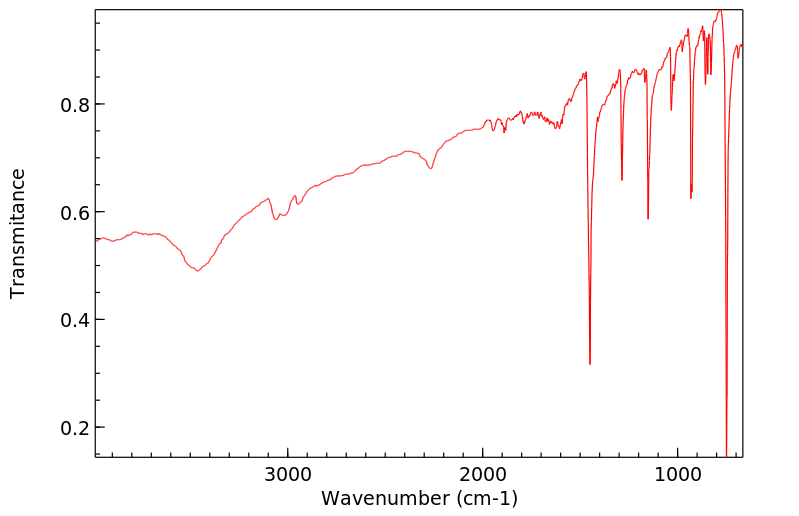9-溴三蝶烯 | 15364-55-3
中文名称
9-溴三蝶烯
中文别名
——
英文名称
9-bromotriptycene
英文别名
9-Brom-triptycen;1-Bromotriptycene;1-Brom-triptycen;9,10(1',2')-Benzenoanthracene, 9-bromo-9,10-dihydro-;1-bromopentacyclo[6.6.6.02,7.09,14.015,20]icosa-2,4,6,9,11,13,15,17,19-nonaene
CAS
15364-55-3
化学式
C20H13Br
mdl
——
分子量
333.227
InChiKey
HSROKCVTEYMWHO-UHFFFAOYSA-N
BEILSTEIN
——
EINECS
——
-
物化性质
-
计算性质
-
ADMET
-
安全信息
-
SDS
-
制备方法与用途
-
上下游信息
-
文献信息
-
表征谱图
-
同类化合物
-
相关功能分类
-
相关结构分类
物化性质
-
熔点:252.0 to 256.0 °C
计算性质
-
辛醇/水分配系数(LogP):5.2
-
重原子数:21
-
可旋转键数:0
-
环数:6.0
-
sp3杂化的碳原子比例:0.1
-
拓扑面积:0
-
氢给体数:0
-
氢受体数:0
安全信息
-
储存条件:室温和干燥环境
SDS
9-溴三蝶烯 修改号码:6
模块 1. 化学品
产品名称: 9-Bromotriptycene
修改号码: 6
模块 2. 危险性概述
GHS分类
物理性危害 未分类
健康危害 未分类
环境危害 未分类
GHS标签元素
图标或危害标志 无
信号词 无信号词
危险描述 无
防范说明 无
模块 3. 成分/组成信息
单一物质/混和物 单一物质
化学名(中文名): 9-溴三蝶烯
百分比: >98.0%(GC)
CAS编码: 15364-55-3
俗名: 9-Bromo-9,10-dihydro-9,10-[1,2]benzenoaNThracene
分子式: C20H13Br
模块 4. 急救措施
吸入: 将受害者移到新鲜空气处,保持呼吸通畅,休息。若感不适请求医/就诊。
皮肤接触: 立即去除/脱掉所有被污染的衣物。用水清洗皮肤/淋浴。
若皮肤刺激或发生皮疹:求医/就诊。
眼睛接触: 用水小心清洗几分钟。如果方便,易操作,摘除隐形眼镜。继续清洗。
如果眼睛刺激:求医/就诊。
食入: 若感不适,求医/就诊。漱口。
紧急救助者的防护: 救援者需要穿戴个人防护用品,比如橡胶手套和气密性护目镜。
模块 5. 消防措施
合适的灭火剂: 干粉,泡沫,雾状水,二氧化碳
特殊危险性: 小心,燃烧或高温下可能分解产生毒烟。
9-溴三蝶烯 修改号码:6
模块 5. 消防措施
特定方法: 从上风处灭火,根据周围环境选择合适的灭火方法。
非相关人员应该撤离至安全地方。
周围一旦着火:如果安全,移去可移动容器。
消防员的特殊防护用具: 灭火时,一定要穿戴个人防护用品。
模块 6. 泄漏应急处理
个人防护措施,防护用具, 使用个人防护用品。远离溢出物/泄露处并处在上风处。
紧急措施: 泄露区应该用安全带等圈起来,控制非相关人员进入。
环保措施: 防止进入下水道。
控制和清洗的方法和材料: 清扫收集粉尘,封入密闭容器。注意切勿分散。附着物或收集物应该立即根据合适的
法律法规处置。
模块 7. 操作处置与储存
处理
技术措施: 在通风良好处进行处理。穿戴合适的防护用具。防止粉尘扩散。处理后彻底清洗双手
和脸。
注意事项: 如果粉尘或浮质产生,使用局部排气。
操作处置注意事项: 避免接触皮肤、眼睛和衣物。
贮存
储存条件: 保持容器密闭。存放于凉爽、阴暗处。
远离不相容的材料比如氧化剂存放。
包装材料: 依据法律。
模块 8. 接触控制和个体防护
工程控制: 尽可能安装封闭体系或局部排风系统,操作人员切勿直接接触。同时安装淋浴器和洗
眼器。
个人防护用品
呼吸系统防护: 防尘面具。依据当地和政府法规。
手部防护: 防护手套。
眼睛防护: 安全防护镜。如果情况需要,佩戴面具。
皮肤和身体防护: 防护服。如果情况需要,穿戴防护靴。
模块 9. 理化特性
固体
外形(20°C):
外观: 晶体-粉末
颜色: 极淡的黄色-浅黄色
气味: 无资料
pH: 无数据资料
熔点:
254°C
沸点/沸程 无资料
闪点: 无资料
爆炸特性
爆炸下限: 无资料
爆炸上限: 无资料
密度: 无资料
溶解度:
[水] 无资料
[其他溶剂] 无资料
9-溴三蝶烯 修改号码:6
模块 10. 稳定性和反应性
化学稳定性: 一般情况下稳定。
危险反应的可能性: 未报道特殊反应性。
须避免接触的物质 氧化剂
危险的分解产物: 一氧化碳, 二氧化碳, 溴化氢
模块 11. 毒理学信息
急性毒性: 无资料
对皮肤腐蚀或刺激: 无资料
对眼睛严重损害或刺激: 无资料
生殖细胞变异原性: 无资料
致癌性:
IARC = 无资料
NTP = 无资料
生殖毒性: 无资料
模块 12. 生态学信息
生态毒性:
鱼类: 无资料
甲壳类: 无资料
藻类: 无资料
残留性 / 降解性: 无资料
潜在生物累积 (BCF): 无资料
土壤中移动性
log水分配系数: 无资料
土壤吸收系数 (Koc): 无资料
亨利定律 无资料
constaNT(PaM3/mol):
模块 13. 废弃处置
如果可能,回收处理。请咨询当地管理部门。建议在可燃溶剂中溶解混合,在装有后燃和洗涤装置的化学焚烧炉中
焚烧。废弃处置时请遵守国家、地区和当地的所有法规。
模块 14. 运输信息
联合国分类: 与联合国分类标准不一致
UN编号: 未列明
模块 15. 法规信息
《危险化学品安全管理条例》(2002年1月26日国务院发布,2011年2月16日修订): 针对危险化学品的安全使用、
生产、储存、运输、装卸等方面均作了相应的规定。
9-溴三蝶烯 修改号码:6
模块16 - 其他信息
N/A
模块 1. 化学品
产品名称: 9-Bromotriptycene
修改号码: 6
模块 2. 危险性概述
GHS分类
物理性危害 未分类
健康危害 未分类
环境危害 未分类
GHS标签元素
图标或危害标志 无
信号词 无信号词
危险描述 无
防范说明 无
模块 3. 成分/组成信息
单一物质/混和物 单一物质
化学名(中文名): 9-溴三蝶烯
百分比: >98.0%(GC)
CAS编码: 15364-55-3
俗名: 9-Bromo-9,10-dihydro-9,10-[1,2]benzenoaNThracene
分子式: C20H13Br
模块 4. 急救措施
吸入: 将受害者移到新鲜空气处,保持呼吸通畅,休息。若感不适请求医/就诊。
皮肤接触: 立即去除/脱掉所有被污染的衣物。用水清洗皮肤/淋浴。
若皮肤刺激或发生皮疹:求医/就诊。
眼睛接触: 用水小心清洗几分钟。如果方便,易操作,摘除隐形眼镜。继续清洗。
如果眼睛刺激:求医/就诊。
食入: 若感不适,求医/就诊。漱口。
紧急救助者的防护: 救援者需要穿戴个人防护用品,比如橡胶手套和气密性护目镜。
模块 5. 消防措施
合适的灭火剂: 干粉,泡沫,雾状水,二氧化碳
特殊危险性: 小心,燃烧或高温下可能分解产生毒烟。
9-溴三蝶烯 修改号码:6
模块 5. 消防措施
特定方法: 从上风处灭火,根据周围环境选择合适的灭火方法。
非相关人员应该撤离至安全地方。
周围一旦着火:如果安全,移去可移动容器。
消防员的特殊防护用具: 灭火时,一定要穿戴个人防护用品。
模块 6. 泄漏应急处理
个人防护措施,防护用具, 使用个人防护用品。远离溢出物/泄露处并处在上风处。
紧急措施: 泄露区应该用安全带等圈起来,控制非相关人员进入。
环保措施: 防止进入下水道。
控制和清洗的方法和材料: 清扫收集粉尘,封入密闭容器。注意切勿分散。附着物或收集物应该立即根据合适的
法律法规处置。
模块 7. 操作处置与储存
处理
技术措施: 在通风良好处进行处理。穿戴合适的防护用具。防止粉尘扩散。处理后彻底清洗双手
和脸。
注意事项: 如果粉尘或浮质产生,使用局部排气。
操作处置注意事项: 避免接触皮肤、眼睛和衣物。
贮存
储存条件: 保持容器密闭。存放于凉爽、阴暗处。
远离不相容的材料比如氧化剂存放。
包装材料: 依据法律。
模块 8. 接触控制和个体防护
工程控制: 尽可能安装封闭体系或局部排风系统,操作人员切勿直接接触。同时安装淋浴器和洗
眼器。
个人防护用品
呼吸系统防护: 防尘面具。依据当地和政府法规。
手部防护: 防护手套。
眼睛防护: 安全防护镜。如果情况需要,佩戴面具。
皮肤和身体防护: 防护服。如果情况需要,穿戴防护靴。
模块 9. 理化特性
固体
外形(20°C):
外观: 晶体-粉末
颜色: 极淡的黄色-浅黄色
气味: 无资料
pH: 无数据资料
熔点:
254°C
沸点/沸程 无资料
闪点: 无资料
爆炸特性
爆炸下限: 无资料
爆炸上限: 无资料
密度: 无资料
溶解度:
[水] 无资料
[其他溶剂] 无资料
9-溴三蝶烯 修改号码:6
模块 10. 稳定性和反应性
化学稳定性: 一般情况下稳定。
危险反应的可能性: 未报道特殊反应性。
须避免接触的物质 氧化剂
危险的分解产物: 一氧化碳, 二氧化碳, 溴化氢
模块 11. 毒理学信息
急性毒性: 无资料
对皮肤腐蚀或刺激: 无资料
对眼睛严重损害或刺激: 无资料
生殖细胞变异原性: 无资料
致癌性:
IARC = 无资料
NTP = 无资料
生殖毒性: 无资料
模块 12. 生态学信息
生态毒性:
鱼类: 无资料
甲壳类: 无资料
藻类: 无资料
残留性 / 降解性: 无资料
潜在生物累积 (BCF): 无资料
土壤中移动性
log水分配系数: 无资料
土壤吸收系数 (Koc): 无资料
亨利定律 无资料
constaNT(PaM3/mol):
模块 13. 废弃处置
如果可能,回收处理。请咨询当地管理部门。建议在可燃溶剂中溶解混合,在装有后燃和洗涤装置的化学焚烧炉中
焚烧。废弃处置时请遵守国家、地区和当地的所有法规。
模块 14. 运输信息
联合国分类: 与联合国分类标准不一致
UN编号: 未列明
模块 15. 法规信息
《危险化学品安全管理条例》(2002年1月26日国务院发布,2011年2月16日修订): 针对危险化学品的安全使用、
生产、储存、运输、装卸等方面均作了相应的规定。
9-溴三蝶烯 修改号码:6
模块16 - 其他信息
N/A
上下游信息
反应信息
-
作为反应物:参考文献:名称:Unconventional synthesis and conformational flexibility of bis(1-triptycyl) ether摘要:DOI:10.1021/jo01300a069
-
作为产物:参考文献:名称:Theilacker,W. et al., Chemische Berichte, 1960, vol. 93, p. 1658 - 1681摘要:DOI:
-
作为试剂:参考文献:名称:Efforts toward the synthesis of liphatic iodonium salts摘要:DOI:10.1021/jo01267a073
文献信息
-
Metal-Free Direct Trifluoromethylthiolation of Aromatic Compounds Using Triptycenyl Sulfide Catalyst作者:Ryo Kurose、Yuji Nishii、Masahiro MiuraDOI:10.1021/acs.orglett.1c00727日期:2021.3.19efficient synthetic method for the electrophilic trifluoromethylthiolation of aromatic compounds. The key is to use triptycenyl sulfide (Trip-SMe) and TfOH to enhance the electrophilicity of SCF3 fragment through the formation of sulfonium intermediates. This method enables direct installation of an SCF3 group onto unactivated aromatics at room temperature, adopting a commercially available saccharin-based
-
Triptycenyl Sulfide: A Practical and Active Catalyst for Electrophilic Aromatic Halogenation Using <i>N</i>-Halosuccinimides作者:Yuji Nishii、Mitsuhiro Ikeda、Yoshihiro Hayashi、Susumu Kawauchi、Masahiro MiuraDOI:10.1021/jacs.9b12672日期:2020.1.22A Lewis base catalyst Trip-SMe (Trip = triptycenyl) for electrophilic aromatic halogenation using N-halosuccinimides (NXS) is introduced. In the presence of an appropriate activator (as a non-coordinating-anion source), a series of unactivated aromatic compounds were halogenated at ambient temperature using NXS. This catalytic system was applicable to transformations that are currently unachievable介绍了一种用于使用 N-卤代琥珀酰亚胺 (NXS) 进行亲电芳香卤化的路易斯碱催化剂 Trip-SMe(Trip = triptycenyl)。在合适的活化剂(作为非配位阴离子源)存在下,一系列未活化的芳香族化合物在环境温度下使用 NXS 进行卤化。该催化体系适用于目前除使用 Br2 或 Cl2 之外无法实现的转化:例如萘的多卤化、BINOL 的区域选择性溴化等。 对照实验表明,三烯基取代基对催化活性起着至关重要的作用,和动力学实验暗示锍盐 [Trip-S(Me)Br][SbF6] 作为活性物质的存在。与简单的二烷基硫醚相比,Trip-SMe 在卤络合物中表现出显着的电荷分离离子对特征,其结构信息是通过单晶 X 射线分析获得的。一项初步的计算研究表明,三烯基官能团的 π 系统是巩固亲电性增强的关键基序。
-
유기전기소자용 화합물, 이를 이용한 유기전기소자 및 그 전자 장치申请人:DUK SAN NEOLUX CO., LTD. 덕산네오룩스 주식회사(120150011099) Corp. No ▼ 161511-0176036BRN ▼312-86-74729公开号:KR20210100352A公开(公告)日:2021-08-17본 발명은 유기전기소자용 화합물, 이를 이용한 유기전기소자 및 상기 유기전기소자를 포함하는 전자장치에 관한 것으로, 본 발명에 따르면 높은 발광효율, 낮은 구동전압 및 고내열성을 가지는 유기전기소자를 제공할 수 있고, 유기전기소자의 색순도 및 수명을 향상시킬 수 있다.本发明涉及用于有机电子器件的化合物,以及使用该化合物的有机电子器件和包含该有机电子器件的电子设备。根据本发明,可以提供具有高发光效率、低驱动电压和耐高温的有机电子器件,并可以改善有机电子器件的颜色纯度和寿命。
-
Air-stable crystalline primary phosphines and germanes: synthesis and crystal structures of dibenzobarellenephosphine and tribenzobarellenegermane作者:Marcin Brynda、Michel Geoffroy、Gérald BernardinelliDOI:10.1039/a901083a日期:——The syntheses of dibenzobarellenephosphine and tribenzobarellenegermane are described; at room temperature these primary phosphines and germanes form air-stable crystals whose structures are reported together with that of tribenzobarellenemethane.
-
Static and Dynamic Stereochemistry of Tris(9-triptycyl)stannane Derivatives作者:Gaku Yamamoto、Shozo Ohta、Megumi Kaneko、Kaoru Mouri、Miki Ohkuma、Ryo Mikami、Yosuke Uchiyama、Mao MinouraDOI:10.1246/bcsj.78.487日期:2005.3Static and dynamic stereochemistry of several tris(9-triptycyl)stannane derivatives Tp 3 SnX (X = H, halogens, and alkyl groups) were studied. X-ray crystallography of the bromo and methyl compounds showed that the Sn atomwas fundamentally tetrahedral and that the three Tp groups meshed with each other like bevel gears and formed a near-C 3 chiral conformation. The rate constants for enantiomerization
表征谱图
-
氢谱1HNMR
-
质谱MS
-
碳谱13CNMR
-
红外IR
-
拉曼Raman
-
峰位数据
-
峰位匹配
-
表征信息
同类化合物
齐斯托醌
黄决明素
马普替林相关物质D
马普替林杂质E(N-甲基马普替林)
马普替林杂质D
马普替林D3
马普替林
颜料黄199
颜料黄147
颜料黄123
颜料黄108
颜料红89
颜料红85
颜料红251
颜料红177
颜料紫27
顺式-1-(9-蒽基)-2-硝基乙烯
阿美蒽醌
阳离子蓝FGL
阳离子蓝3RL
长蠕孢素
镁蒽四氢呋喃络合物
镁蒽
锈色洋地黄醌醇
锂钠2-[[4-[[3-[(4-氨基-9,10-二氧代-3-磺基-1-蒽基)氨基]-2,2-二甲基-丙基]氨基]-6-氯-1,3,5-三嗪-2-基]氨基]苯-1,4-二磺酸酯
锂胭脂红
链蠕孢素
铷离子载体I
铝洋红
铂(2+)二氯化1-({2-[(2-氨基乙基)氨基]乙基}氨基)蒽-9,10-二酮(1:1)
钾6,11-二氧代-6,11-二氢-1H-蒽并[1,2-d][1,2,3]三唑-4-磺酸酯
钠alpha-(丙烯酰氨基)-[4-[[9,10-二氢-4-(异丙基氨基)-9,10-二氧代-1-蒽基]氨基]苯氧基]甲苯磺酸盐
钠[[3-[[4-(环己基氨基)-9,10-二氢-9,10-二氧代-1-蒽基]氨基]-1-氧代丙基]氨基]苯磺酸盐
钠[3-[[9,10-二氢-4-(异丙基氨基)-9,10-二氧代-1-蒽基]氨基]丁基]苯磺酸盐
钠6,11-二氧代-6,11-二氢-1H-蒽并[1,2-d][1,2,3]三唑-4-磺酸酯
钠4-({4-[乙酰基(乙基)氨基]苯基}氨基)-1-氨基-9,10-二氧代-9,10-二氢-2-蒽磺酸酯
钠2-[(4-氨基-9,10-二氧代-3-磺基-9,10-二氢-1-蒽基)氨基]-4-{[2-(磺基氧基)乙基]磺酰基}苯甲酸酯
钠1-氨基-9,10-二氢-4-[[4-(1,1-二甲基乙基)-2-甲基苯基]氨基]-9,10-二氧代蒽-2-磺酸盐
钠1-氨基-4-[(3-{[(4-甲基苯基)磺酰基]氨基}苯基)氨基]-9,10-二氧代-9,10-二氢-2-蒽磺酸酯
钠1-氨基-4-[(3,4-二甲基苯基)氨基]-9,10-二氧代-9,10-二氢-2-蒽磺酸酯
钠1-氨基-4-(1,3-苯并噻唑-2-基硫基)-9,10-二氧代蒽-2-磺酸盐
醌茜隐色体
醌茜素
酸性蓝P-RLS
酸性蓝41
酸性蓝27
酸性蓝127:1
酸性紫48
酸性紫43
酸性兰62







